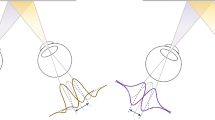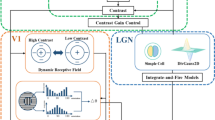Abstract
Contour detection is the basic content of image processing and plays an important role in image analysis and target recognition. This paper proposed a contour perception model that simulates the complex connection pattern of the visual cortex. The connection included the feedforward input from the lateral geniculate body (LGN), the horizontal input from the neurons in the same layer, and the feedback input from the advanced visual cortex. Using the sparse coding characteristics of the LGN, the windmill-like structure receptive field of the primary visual cortex, and the hue perception characteristics of the advanced visual cortex to improve the accuracy of the contour extracted by the proposed model. Choosing the BSDS500 natural scene dataset as the experimental object, the F-score is selected as the evaluation index. The average optimal F-score of the proposed method is 0.72, which is better than other mainstream biological vision-based methods. Concurrently, the NYUD dataset is used for further verification. To comprehensively verify the effectiveness of the model proposed in this paper, Performance-value rather than F-score is selected as the evaluation index. The average optimal Performance-value of the proposed method is 0.42, which shows better results, too. The complex connection pattern allows neural encoding and decoding to make full use of the characteristics of information exchange between the visual cortexes, which is more in line with the biological vision system.









Similar content being viewed by others
References
Akbarinia A, Parraga CA (2018) Feedback and surround modulated boundary detection[J]. Int J Comput Vision 126(12):1367–1380
Alpert S, Galun M, Brandt A et al (2011) Image segmentation by probabilistic bottom-up aggregation and cue integration[J]. IEEE Trans Pattern Anal Mach Intell 34(2):315–327
Arbelaez P, Maire M, Fowlkes C et al (2010) Contour detection and hierarchical image segmentation[J]. IEEE Trans Pattern Anal Mach Intell 33(5):898–916
Azzopardi G, Petkov N (2012) A CORF computational model of a simple cell that relies on LGN input outperforms the Gabor function model[J]. Biol Cybern 106(3):177–189
Bertasius G, Shi J, Torresani L (2015) Deepedge: a multi-scale bifurcated deep network for top-down contour detection[C]. Proceedings of the IEEE conference on computer vision and pattern recognition. IEEE, Boston, pp 4380–4389
Buchsbaum G, Gottschalk A (1983) Trichromacy, opponent colours coding and optimum colour information transmission in the retina[J]. Proc R Soc Lond Ser B Biol Sci 220(1218):89–113
Canny J (1986) A computational approach to edge detection[J]. IEEE Trans Pattern Anal Mach Intell 8(6):679–698
Cao YJ, Lin C, Pan YJ et al (2019) Application of the center–surround mechanism to contour detection[J]. Multimed Tools Appl 78(17):25121–25141
Capparelli F, Pawelzik K, Ernst U (2019) Constrained inference in sparse coding reproduces contextual effects and predicts laminar neural dynamics[J]. PLoS Comput Biol 15(10):e1007370
Dollár P, Zitnick CL (2013) Structured forests for fast edge detection[C]. Proceedings of the IEEE international conference on computer vision. IEEE, Sydney, pp 1841–1848
Fang T, Fan Y, Wu W (2020) Salient contour detection on the basis of the mechanism of bilateral asymmetric receptive fields[J]. SIViP 14(7):1461–1469
Grigorescu C, Petkov N, Westenberg MA (2003) Contour detection based on nonclassical receptive field inhibition[J]. IEEE Trans Image Process 12(7):729–739
Hubel DH, Wiesel TN (1962) Receptive fields, binocular interaction and functional architecture in the cat’s visual cortex[J]. J Physiol 160(1):106–154
Jacob T, Snyder W, Feng J et al (2016) A neural model for straight line detection in the human visual cortex[J]. Neurocomputing 199:185–196
Li M, Song XM, Xu T et al (2019) Subdomains within orientation columns of primary visual cortex[J]. Sci Adv 5(6):eaaw0807
Lim JJ, Zitnick CL, Dollár P (2013) Sketch tokens: a learned mid-level representation for contour and object detection[C]. Proceedings of the IEEE conference on computer vision and pattern recognition. IEEE, Portland, pp 3158–3165
Lin C, Zhao HJ, Cao YJ (2019) Improved color opponent contour detection model based on dark and light adaptation[J]. Autom Control Comput Sci 53(6):560–571
Liu Y, Cheng MM, Hu X et al (2017) Richer convolutional features for edge detection[C]. Proceedings of the IEEE conference on computer vision and pattern recognition. IEEE, Hawaii, pp 3000–3009
Liu Z, Zhang W, Zhao P (2020) A cross-modal adaptive gated fusion generative adversarial network for RGB-D salient object detection[J]. Neurocomputing 387:210–220
Liu L, Zhang J, Saad MA et al (2020) Blind S3D image quality prediction using classical and non-classical receptive field models[J]. Sig Process Image Commun 87:115915
Ma W, Gong C, Xu S et al (2020) Multi-scale spatial context-based semantic edge detection[J]. Inf Fusion 64:238–251
Martin DR, Fowlkes CC, Malik J (2004) Learning to detect natural image boundaries using local brightness, color, and texture cues[J]. IEEE Trans Pattern Anal Mach Intell 26(5):530–549
Melotti D, Heimbach K, Rodríguez-Sánchez A et al (2020) A robust contour detection operator with combined push-pull inhibition and surround suppression[J]. Inf Sci 524:229–240
Mingolla E, Ross W, Grossberg S (1999) A neural network for enhancing boundaries and surfaces in synthetic aperture radar images[J]. Neural Netw 12(3):499–511
Mohan YS, Jayakumar J, Lloyd EKJ et al (2019) Diversity of feature selectivity in macaque visual cortex arising from a limited number of broadly tuned input channels[J]. Cereb Cortex 29(12):5255–5268
Moratti S, Méndez-Bértolo C, Del-Pozo F et al (2014) Dynamic gamma frequency feedback coupling between higher and lower order visual cortices underlies perceptual completion in humans[J]. NeuroImage 86:470–479
Murgas KA, Wilson AM, Michael V et al (2020) Unique spatial integration in mouse primary visual cortex and higher visual areas[J]. J Neurosci 40(9):1862–1873
Nathans J, Thomas D, Hogness DS (1986) Molecular genetics of human color vision: the genes encoding blue, green, and red pigments[J]. Science 232(4747):193–202
Palmerston JB, Zhou Y, Chan RHM (2020) Comparing biological and artificial vision systems: network measures of functional connectivity[J]. Neurosci Lett 739:135407
Wang Y, Zhao X, Li Y et al (2018) Deep crisp boundaries: From boundaries to higher-level tasks[J]. IEEE Trans Image Process 28(3):1285–1298
Wu R, Feng M, Guan W et al (2019) A mutual learning method for salient object detection with intertwined multi-supervision[C]. Proceedings of the IEEE/CVF conference on computer vision and pattern recognition. IEEE, Long Beach, pp 8150–8159
Xie S, Tu Z (2015) Holistically-nested edge detection[C]. Proceedings of the IEEE conference on computer vision and pattern recognition. IEEE, Boston, pp 1395–1403
Yang KF, Li CY, Li YJ (2014) Multifeature-based surround inhibition improves contour detection in natural images[J]. IEEE Trans Image Process 23(12):5020–5032
Yang KF, Gao SB, Guo CF et al (2015) Boundary detection using double-opponency and spatial sparseness constraint[J]. IEEE Trans Image Process 24(8):2565–2578
Yang H, Li Y, Yan X et al (2019) ContourGAN: Image contour detection with generative adversarial network[J]. Knowl Based Syst 164:21–28
Yoav B (1988) Opening the Box of a Boxplot. Am Stat 42(4):257. https://doi.org/10.2307/2685133
Yuan B, Han L, Yan H (2021) Explore double-opponency and skin color for saliency detection[J]. Neurocomputing 425:219–230
Zhang H, Sindagi V, Patel VM (2019) Image de-raining using a conditional generative adversarial network[J]. IEEE Trans Circuits Syst Video Technol 30(11):3943–3956
Zhang Y, Tian Y, Kong Y et al (2020) Residual dense network for image restoration[J]. IEEE Trans Pattern Anal Mach Intell 43(7):2480–2495
Zhang Q, Lin C, Li F (2021) Application of binocular disparity and receptive field dynamics: A biologically-inspired model for contour detection[J]. Pattern Recogn 110:107657
Acknowledgements
This work has been supported by the Laboratory of Pattern Recognition and Image Processing in Hangzhou Dianzi University.
Author information
Authors and Affiliations
Corresponding author
Ethics declarations
We declare that we have no financial and personal relationships with other people or organizations that can inappropriately influence our work, there is no professional or other personal interest of any nature or kind in any product, service and/or company that could be construed as influencing the position presented in, or the review of, the manuscript entitled “A contour perception model that simulates the complex connection pattern of the visual cortex”.
Additional information
Publisher’s note
Springer Nature remains neutral with regard to jurisdictional claims in published maps and institutional affiliations.
Rights and permissions
Springer Nature or its licensor (e.g. a society or other partner) holds exclusive rights to this article under a publishing agreement with the author(s) or other rightsholder(s); author self-archiving of the accepted manuscript version of this article is solely governed by the terms of such publishing agreement and applicable law.
About this article
Cite this article
Cai, Z., Fan, Y. A contour perception model that simulates the complex connection pattern of the visual cortex. Multimed Tools Appl 82, 19347–19368 (2023). https://doi.org/10.1007/s11042-022-14194-z
Received:
Revised:
Accepted:
Published:
Issue Date:
DOI: https://doi.org/10.1007/s11042-022-14194-z




